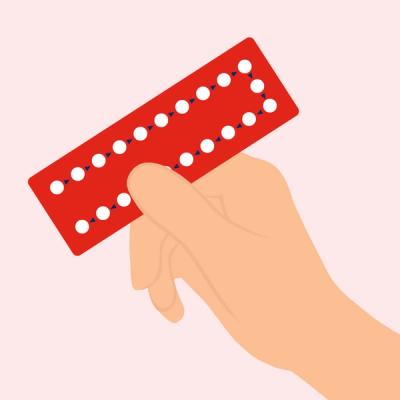Xulane® Transdermal Patch FAQs
-
Estrogen and progestin transdermal (patch) contraceptives are used to prevent pregnancy. Estrogen (ethinyl estradiol) and progestin (levonorgestrel or norelgestromin) are two female sex hormones. Combinations of estrogen and progestin work by preventing ovulation (the release of eggs from the ovaries) and by changing the cervical mucus and the lining of the uterus. The contraceptive patch is a very effective method of birth control, but it does not prevent the spread of human immunodeficiency virus (HIV; the virus that causes acquired immunodeficiency syndrome [AIDS]) and other sexually transmitted diseases.
-
Transdermal estrogen and progestin contraceptives come as a patch to apply to the skin. One patch is applied once a week for three weeks, followed by a patch-free week. Follow the directions on your prescription label carefully and ask your doctor or pharmacist to explain any part you do not understand. Use the contraceptive patch exactly as directed.
If you are just starting to use the Xulane brand estrogen and progestin contraceptive patch, you may apply your first patch on the first day of your menstrual period or on the first Sunday after your period begins. If you apply your first patch after the first day of your menstrual period, you must use a backup method of birth control (such as a condom and/or a spermicide) for the first seven days of the first cycle. Talk to your doctor or pharmacist to find out when in your cycle you should start using your contraceptive patch.
When changing your patch, always apply your new patch on the same day of the week (the Patch Change Day). Apply a new patch once a week for three weeks. During week four, remove the old patch but do not apply a new patch, and expect to begin your menstrual period. On the day after week four ends, apply a new patch to start a new four-week cycle even if your menstrual period has not started or has not ended. You should not go more than seven days without a patch.
Apply the contraceptive patch to a clean, dry, intact, healthy area of skin on the buttock, abdomen, upper outer arm or upper torso in a place where it will not be rubbed by tight clothing. Do not place the contraceptive patch on the breasts or on skin that is red, irritated or cut. Do not apply makeup, creams, lotions, powders or other topical products to the skin area where the contraceptive patch is placed. Each new patch should be applied to a new spot on the skin to help avoid irritation.
Do not cut, decorate or change the patch in any way. Do not use extra tape, glue or wraps to hold the patch in place.
Each brand of estrogen and progestin contraceptive patches should be applied following the specific directions given in the manufacturer's information for the patient. Read this information carefully before you start using estrogen and progestin contraceptive patches, and each time you refill your prescription. Ask your doctor or pharmacist if you have any questions. The following general directions can help you remember some important things to do when you apply any type of estrogen and progestin contraceptive patch:
Tear open the pouch with your fingers. Do not open the pouch until you are ready to apply the patch.
Remove the patch from the pouch. Be careful not to remove the clear plastic liner as you remove the patch.
Peel away half or the larger part of the plastic liner. Avoid touching the sticky surface of the patch.
Apply the sticky surface of the patch to the skin and remove the other part of the plastic liner. Press down firmly on the patch with the palm of your hand for 10 seconds, making sure that the edges stick well.
After one week, remove the patch from your skin. Fold the used patch in half soit sticks to itself and dispose of it soit is out of the reach of children and pets. Do not flush the used patch down the toilet.
Check your patch every day to make sure it is sticking. If the patch has been partially or completely detached for less than one day, try to reapply it in the same place immediately. Do not try to reapply a patch that is no longer sticky, that has stuck to itself or another surface, that has any material stuck to its surface, or that has loosened or fallen off before. Apply a new patch instead. Your Patch Change Day will stay the same. If the patch has been partially or completely detached for more than one day, or if you do not know how long the patch has been detached, you may not be protected from pregnancy. You must start a new cycle by applying a new patch immediately; the day that you apply the new patch becomes your new Patch Change Day. Use backup birth control for the first week of the new cycle.
If the skin under your patch becomes irritated, you may remove the patch and apply a new patch to a different spot on the skin. Leave the new patch in place until your regular Patch Change Day. Be sure to remove the old patch because you should never wear more than one patch at a time.
-
It may take up to a week for the Xulane patch to protect against pregnancy. The first week of use, and for the first week of each new four-week cycle, use backup birth control method, like condoms, to help prevent pregnancy.
-
Xulane birth control patch is available by prescription only. You cannot get birth control patches over the counter.1 You can buy Xulane online with a prescription from Redbox Rx.
-
If Xulane is unavailable, another generic equivalent like Zafemy or norelgestromin/ethinyl estradiol may be prescribed. These generics contain the same active ingredients as Xulane and offer the same effectiveness.
-
Xulane is just under $33 per patch with RedBox Rx. No insurance required.
-
Before using the Xulane estrogen and progestin contraceptive patch:
Tell your doctor and pharmacist if you are allergic to estrogens, progestins, any other medications, or any of the ingredients in estrogen and progestin contraceptive patches. Ask your pharmacist for a list of the ingredients.
Tell your doctor if you are using any other type of hormonal birth control, such as pills, rings, injections or implants. Your doctor will tell you how and when you should stop using the other type of birth control and start using the contraceptive patch. Do not use any other type of hormonal birth control while you are using the contraceptive patch.
Tell your doctor if you are taking the combination of ombitasvir, paritaprevir or ritonavir (Technivie) with or without dasabuvir (in Viekira Pak). Your doctor will probably tell you not to use an estrogen and progestin contraceptive patch if you are taking these medications.
Tell your doctor and pharmacist what prescription and nonprescription medications, vitamins and nutritional supplements you are taking. Be sure to mention any of the following: acetaminophen (APAP, Tylenol); anticoagulants (blood thinners) such as warfarin (Coumadin); antifungals such as fluconazole (Diflucan), itraconazole (Onmel, Sporanox, TOLSURA), ketoconazole or voriconazole (Vfend); aprepitant (Emend); ascorbic acid (vitamin C); atorvastatin (LIPITOR, in Caduet); barbiturates such as phenobarbital; boceprevir (no longer available in U.S.); bosentan (TRACLEER); clofibrate (no longer available in the US); colesevelam (Welchol); cyclosporine (Gengraf, Neoral, Sandimmune); griseofulvin (Gris-PEG); medications for HIV such as atazanavir (Reyataz, in Evotaz), darunavir (Prevista, in SYMTUZA, in PREZCOBIX), etravirine (Intelence), fosamprenavir (Lexiva), indinavir (Crixivan), lopinavir (in Kaletra), nelfinavir (Viracept), nevirapine (Viramune), ritonavir (Norvir, in Kaletra, in Viekira Pak) or tipranavir (Aptivus); medications for seizures such as carbamazepine (Carbatrol, Equetro, Tegretol, others), felbamate (Felbatol), lamotrigine (Lamictal), oxcarbazepine (Oxtellar XR, Trileptal), phenytoin (Dilantin, Phenytek), rufinamide (Banzel) or topiramate (Qudexy, Topamax, Trokendi, in Qysmia); morphine (Kadian, MS Contin); oral steroids such as dexamethasone (Hemady), methylprednisolone (Medrol), prednisone (Rayos) or prednisolone (Orapred ODT, Prelone); rifampin (Rifadin, Rimactane, in Rifamate, in Rifater); rosuvastatin (Ezallor Sprinkle, Crestor); tizanidine (Zanaflex); telaprevir (no longer available in U.S.); temazepam (Restoril); theophylline (Theo-24, Theochron); or thyroid medications such as levothyroxine (Levo-T, LEVOXYL, Synthroid, Tirosint, others). Your doctor may need to change the doses of your medications or monitor you carefully for side effects. Many other medications may also interact with estrogen and progestin contraceptive patches, so be sure to tell your doctor about all the medications you are taking, even those that do not appear on this list.
Tell your doctor what herbal products you are taking, especially products containing St. John's wort.
Tell your doctor if you have recently had surgery or if you are on bed rest. Also tell your doctor if you have or have ever had a heart attack; a stroke; blood clots in your legs, lungs or eyes; thrombophilia (condition in which the blood clots easily); chest pain due to heart disease; cancer of the breasts, lining of the uterus, cervix or vagina; vaginal bleeding between menstrual periods; hepatitis (swelling of the liver); yellowing of the skin or eyes, especially while you were pregnant or using hormonal contraceptives; a liver tumor; headaches that happen with other symptoms such as weakness or difficulty seeing or moving; high blood pressure; diabetes that has caused problems with your kidneys, eyes, nerves or blood vessels; or heart valve disease. Your doctor will probably tell you that you should not use the contraceptive patch.
Tell your doctor if you have recently given birth, had a miscarriage or abortion, if you weigh 198 pounds or more, or if you swim regularly or for long periods of time (30 minutes or more). Also tell your doctor if anyone in your family has ever had breast cancer, or if you have or have ever had breast lumps, fibrocystic disease of the breast (condition in which lumps or masses that are not cancer form in the breasts) or an abnormal mammogram (X-ray of the breasts). Also tell your doctor if you or anyone in your family have or have ever had high blood cholesterol and fats; diabetes; asthma; migraines or other types of headaches; depression; seizures; scanty or irregular menstrual periods; angioedema (a condition that causes difficulty swallowing or breathing and painful swelling of the face, throat, tongue, lips, eyes, hands, feet, ankles or lower legs); or liver, heart, gallbladder or kidney disease.
Tell your doctor if you are pregnant, plan to become pregnant or are breastfeeding. If you become pregnant while using estrogen and progestin contraceptive patches, call your doctor immediately. You should suspect that you are pregnant and call your doctor if you have used the contraceptive patch correctly and you have missed two periods in a row, or if you have not used the contraceptive patch correctly and you have missed one period.
If you are having surgery, including dental surgery, tell the doctor or dentist that you are using an estrogen and progestin contraceptive patch. Talk to your doctor about this as soon as your surgery is scheduled, because your doctor may want you to stop using the contraceptive patch several weeks before your surgery.
Tell your doctor if you wear contact lenses. If you notice changes in your vision or ability to wear your lenses while using an estrogen and progestin contraceptive patch, see an eye doctor.
You should know that when you use the contraceptive patch, the average amount of estrogen in your blood will be higher than it would be if you used an oral contraceptive (birth control pill), and this may increase the risk of serious side effects such as blood clots in the legs or lungs. Talk to your doctor about the risks of using the contraceptive patch.
-
Talk to your doctor about eating grapefruit and drinking grapefruit juice while using this contraceptive patch.
-
If you forget to apply your patch at the start of any patch cycle (week one, day one), you may not be protected from pregnancy. Apply the first patch of the new cycle as soon as you remember. There is now a new Patch Change Day and a new day one. Use a backup method of birth control for one week.
If you forget to change your patch in the middle of the patch cycle (week two or week three) for one or two days, apply a new patch immediately and apply the next patch on your usual Patch Change Day. If you forget to change your patch in the middle of the cycle for more than two days, you may not be protected from pregnancy. Stop the current cycle and start a new cycle immediately by applying a new patch. There is now a new Patch Change Day and a new day one. Use a backup method of birth control for one week.
If you forget to remove your patch at the end of the patch cycle (week four), take it off as soon as you remember. Start the next cycle on the usual Patch Change Day, the day after day 28.
-
If you stop using Xulane, you will no longer be protected against pregnancy unless you use an alternative birth control method. When you stop using Xulane, your body will return to its normal state before the birth control patch.2
-
The estrogen and progestin contraceptive patch may cause side effects. Tell your doctor if any of these symptoms are severe or do not go away:
Irritation, redness or rash in the place where you applied the patch.
Breast tenderness, enlargement or discharge.
Nausea.
Vomiting.
Stomach cramps or bloating.
Weight gain.
Change in appetite.
Acne.
Hair loss.
Bleeding or spotting between menstrual periods.
Changes in menstrual flow.
Painful or missed periods.
Vaginal itching or irritation.
White vaginal discharge.
Some side effects can be serious. If you experience any of the following symptoms, call your doctor immediately:
Sudden severe headache, vomiting, dizziness or fainting.
Sudden speech problems.
Weakness or numbness of an arm or leg.
Sudden partial or complete loss of vision.
Double vision or changes in vision.
Bulging eyes.
Crushing chest pain.
Chest heaviness.
Coughing up blood.
Shortness of breath.
Pain in the back of the lower leg.
Severe stomach pain.
Sleep problems, mood changes or other signs of depression.
Yellowing of the skin or eyes, loss of appetite, dark urine, extreme tiredness, weakness or light-color bowel movements.
Dark patches of skin on forehead, cheeks, upper lip and/or chin.
Swelling of the eyes, face, tongue, throat, hands, feet, ankles or lower legs.
-
Keep this medication in the container it came in, tightly closed, and out of reach of children. Store it at room temperature and away from excess heat and moisture (not in the bathroom).
Unneeded medications should be disposed of in special ways to ensure that pets, children and other people cannot consume them. However, you should not flush this medication down the toilet. Instead, the best way to dispose of your medication is through a medicine take-back program. Talk to your pharmacist or contact your local garbage/recycling department to learn about take-back programs in your community.
-
In case of overdose, remove all the patches that were applied and call your local poison control center at 1-800-222-1222. If the victim has collapsed or is not breathing, call local emergency services at 911.
-
Keep all appointments with your doctor and the laboratory. You should have a complete physical examination every year, including blood pressure measurements, and breast and pelvic exams. Follow your doctor's directions for examining your breasts; report any lumps immediately.
Before you have any laboratory tests, tell the laboratory personnel that you use an estrogen and progestin contraceptive patch, as this medication may interfere with some laboratory tests.
Do not let anyone else use your medication. Ask your pharmacist any questions you have about refilling your prescription.
It is important for you to keep a written list of all the prescription and nonprescription (over the counter) medicines you are taking, as well as any products such as vitamins, minerals or other dietary supplements. You should bring this list with you each time you visit a doctor or if you are admitted to a hospital. It is also important information to carry with you in case of emergencies.




